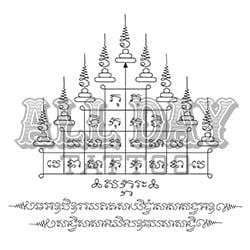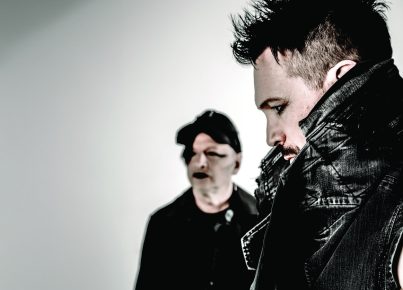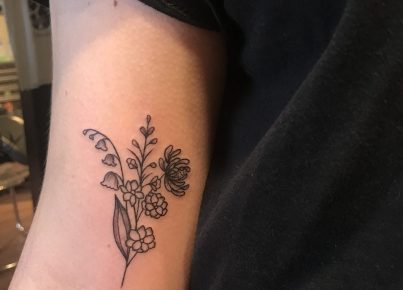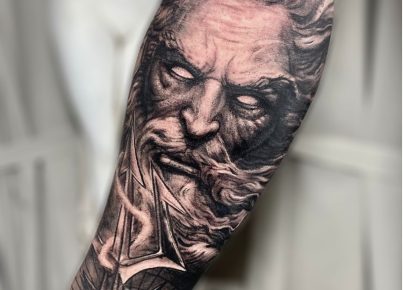
The “Gao Yord” is a popular design in the Sak Yant (Thai Traditional tattoos) style
In this article we are going to have an in depth look at the Gao Yord design
If you would like to read more about Sak Yant in general you can check out our detailed article here
The word “Gao” is translated to “nine” and the word “Yord” is translated to “peaks” or “spires”
In Thai script Gao Yord is written as “เก้ายอด”
The nine peaks symbolize the sacred Mount Meru (also known as Sumeru) in Buddhist mythology
This is an important symbol in both Buddhist and Hindu belief and represents the mythical “mountain of the Gods”
The design is believed to offer a wide range of powers and protections, making it a highly sought after design for people looking for a tattoo that’s not only beautiful, but has an important deeper meaning too
The Gao Yord, or “nine peaks” tattoo represents a physical embodiment of Buddhist teachings, protection and spiritual growth
In Thailand, Buddhist beliefs have shaped much of the culture you see today
So much so, that the word “Yord” is used to describe something being the “best”
You may hear (or use!) the phrase “Sud Yord”, written in Thai as “สุดยอด” to say something is great
While the translation would be something along the lines of “that’s awesome!” the direct translation is “the highest peak!”
The number 9 has an important meaning in both Thai culture in general, as well as the Buddhist beliefs that influenced it
Apart from the obvious “nine peaks” there are other important symbols contained in the Gao Yord design

The script (lettering) is known as Khom script which has a deep history in the region
The designs contain representations of the Buddha in a form that can be seen across a large variety of Sak Yant designs
At the top of each Buddha is a swirling symbol called an Unalome.
Let’s have a deeper look at each element
The Nine Peaks of Mount Meru in the Gao Yord Design
Mount Meru holds an important position in the cosmology of Buddhism
Although it is not thought to represent a physical mountain that can be found in our world, it is revered as the spiritual center of all universes
It is considered to be the “cosmic axis” which unites all physical, metaphysical and spiritual realms
In the Buddhist scriptures it is often depicted as an enormous mountain with its roots deeply grounded in the underworld, and its peaks touching the heavens
Various layers of heavens, hells and earthly realms exist within its sphere, which symbolizes the multilayered complexity of existence

In Buddhism, Mount Meru is believed to be the dwelling place of the gods
In this place, important celestial events take place
It represents the epitome of spiritual growth and serves as a spiritual reminder of the challenging spiritual journey someone must walk towards enlightenment
Each level of the mountain embodies a stage of enlightenment and reaching the top signifies the attainment of ultimate wisdom and the state of Nirvana (known as Nibbana in Theravada Buddhism – the specific arm of Buddhism most prevalent in Thailand)
In this way, the Mount Meru symbolized in the Gao Yord design symbolizes a spiritual path and embodies that journey that Buddhists must take towards Nirvana
The Number Nine in the Gao Yord Design
In Thai culture and, by extension, Thai Buddhism the number nine holds a great significance
The number is often associated with prosperity, progress and spiritual growth
The Thai word for nine is “Gao”, written in Thai script as “เก้า”
The pronunciation is the same for the word which means “progress”, which creates a type of phonetic symbolism that reinforces the significance of the word
In Buddhism, the number nine is associated with the Buddha and his teachings
Specifically, the nine virtues of the Buddha that faithful followers try to emulate:
- Araham: Think of this as the “Buddha, the Worthy One.” This means Buddha, because of his enlightenment, is free from anything that ties people to the constant cycle of life and death.
- Sammasambuddho: This one’s about “Buddha, the Self-Enlightened.” Unlike others who reached enlightenment with help, Buddha figured it out all by himself.
- Vijja-carana-sampanno: This is “Buddha, the Wise and Moral.” He’s the ultimate example of wisdom and good behavior.
- Sugato: This one translates to “Buddha, the Well-Gone.” It’s all about how Buddha has successfully followed the noble path to its end, reaching Nirvana.
- Lokavidu: This means “Buddha, the World-Knower.” It emphasizes Buddha’s complete understanding of all the different layers of existence.
- Anuttaro purisa-damma-sarathi: This is about “Buddha, the Supreme Guide.” He compassionately leads his followers, directing them away from danger and towards enlightenment.
- Sattha deva-manussanam: This one’s “Buddha, the Teacher of Gods and Humans.” His teachings are so powerful that they guide everyone, even celestial beings, towards enlightenment.
- Buddho: Simply put, this means “Buddha, the Awakened One.” It’s all about Buddha’s full enlightenment, having woken up from the ignorance that keeps beings stuck in the cycle of birth and death.
- Bhagava: Often translated as “Buddha, the Blessed One,” this highlights the blessings that come from Buddha’s supreme enlightenment.
The nine Buddhas in the Gao Yord design symbolize these virtues
If you visit any Thai temples, you’ll see that many of the most significant buildings have nine spires, see if you can count them as you walk around!

Each Buddha serves as a reminder for the wearer of the virtues and provides spiritual guidance to the wearer
What is the Script or Language used in the Gao Yord Design?
The lettering included in the Gao Yord is known as “Khom” script
Khom is also referred to as Ancient Khmer or Khmer script
It is an “alphasyllabary” script which is a writing system where each symbol or character represents a consonant-vowel sequence, rather than just a single consonant or vowel like in the Latin alphabet
The roots of the script can be traced back to the Brahmi script in ancient India
It found extensive usage across Cambodia (the former Khmer Empire), Laos, Thailand and parts of Vietnam
In Sak Yant, the Khom script’s usage is an important part of the art form’s spiritual essence
Khom is seen as a bearer of powerful spiritual energy
It is used to etch prayers, mantras and specific symbols into the skin, with each element carrying a unique and spiritual meaning and blessing
The version of Khom script you see in Sak Yant designs has been carefully handed down from Sak Yant masters (known as “Ajarns”) to their apprentices over centuries

The script or lettering you see can rarely be “read” in any traditional sense
Rather the Ajarn that created the design, uses specific letters and symbols to impart a particular blessing or power
The designs that we have are sourced from well respected Ajarns and checked for authenticity
So while we can’t tell you exactly what any part of the design says, we can tell you the meanings that are bestowed in the Gao Yord design
The Meanings of the Script in the Gao Yord Design
- Maeta Ma Hah Niyom: Think of this as the “everyone loves you” blessing. People will be kind and compassionate towards you, making you popular and often the favorite.
- Klaeoklad: This one’s like a safety net. It helps you avoid serious harm.
- Chana Satru: Need to overcome a challenge? This gives you the power to defeat enemies.
- Ma Hah Amnat: The boss level blessing. It gives you power, control, and authority over others.
- Awk Seuk: This shows you’re ready to fight for your beliefs or for those you care about. It’s about standing up for what’s right.
- Kong Kra Phan: Your personal magic shield. It provides protection and is believed to even make you invincible.
- Oopatae: The business blessing. Helps you succeed in your work or business endeavors, ensuring everything runs smoothly.
- Ma Hah Saneh: The charm and attraction booster. Increases your popularity and makes you more attractive to others.
- Ma Hah Lap: The good luck charm. It brings you a lot of good fortune and luck.
- Noon Chataa: This blessing is all about giving your fate a boost. It works to improve your destiny.
- Pong Gan Antarai: The guardian angel blessing. It protects you from accidents, including natural disasters, and from violent actions.
- Nah Tee Gan Ngan Dee: Your work life enhancer. It helps to make your work circumstances better.
The Body of the Buddha in the Gao Yord Design

The Gao Yord design showcases three oval shapes, repeated nine times
Each oval embodies the Buddha, his teachings, and enlightenment
The nine repetitions are not arbitrary – each holds a special meaning
- The first repetition represents the Buddha’s virtue of being worthy of respect
- The second echoes the supreme self-enlightenment he achieved
- The third signifies his embodiment of wisdom and morality
- The fourth celebrates the Buddha’s journey towards Nirvana
- The fifth highlights his knowledge of all realms of existence
- The sixth underscores his role as a master guide, steering us towards enlightenment
- The seventh and eighth repetitions honor the Buddha as a teacher of both humans and celestial beings
- The ninth stands for his full enlightenment and blessedness
When etched on your skin, they serve as a living testament
A testament to Buddha’s teachings, your journey, and your dedication
This tattoo is not just a piece of art
It’s a personal declaration, a guiding light on your spiritual path
The Unalome in the Gao Yord Design

Meet the “unalome” – a cherished symbol in Buddhist art
Its intricate design mirrors the path to enlightenment
Just like life, the path of the unalome isn’t a straight line
It’s full of twists, turns, and unexpected detours
It echoes the hurdles and setbacks we face
Even stepping back is a part of the journey
But every challenge is a stepping stone towards enlightenment
And then the path straightens out
This signifies the moment of enlightenment – pure clarity of mind and spirit
That’s the essence of the unalome and the ovals – a journey, a destination, and a symbol of the Buddha’s presence.

At ALL DAY Tattoo, we pride ourselves on our extensive experience with Gao Yord designs
We are not just another tattoo studio in Bangkok; we’re fully licensed and strictly follow top-notch Western hygiene practices, ensuring a safe and clean environment for your tattoo journey
The inks we use aren’t just any inks – they’re premium quality, FDA-approved brands all the way from the USA, ensuring the best outcome for your tattoo
You can rest assured knowing that we prioritize quality and safety
We’re not in the business of tricking our customers. When you choose us, you’re choosing transparency, fairness, and no tourist scams (insert https://www.alldaytattoo.com/sak-yant-tattoos-bangkok/#Avoid_the_%E2%80%9CTourist_Trap%E2%80%9D_or_Scams_at_tattoo_studios_in_Thailand)
Our goal is to give you a memorable tattoo experience, not just a service
Located in the heart of Bangkok, we’re easy to find
Our team is not only friendly but also fluent in English, ready to guide you every step of the way through the process of getting a Gao Yord tattoo
Feel free to reach out to our team using any of the contact methods below – they’re always ready to assist and advise you






